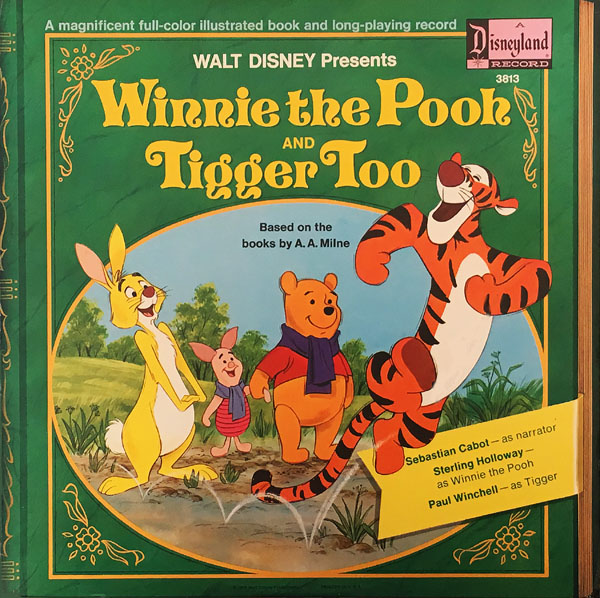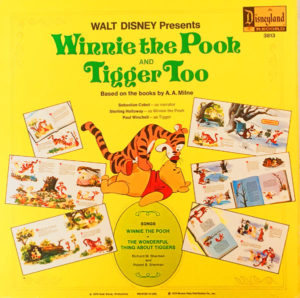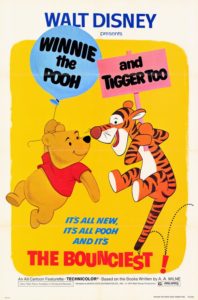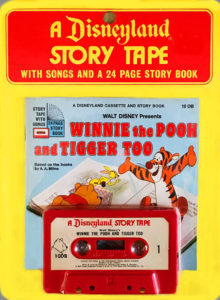The last Pooh featurette to be released during Disneyland Records’ original vinyl era was also the only one to feature Paul Winchell as Tigger—and win a Grammy.

Walt Disney Presents
WINNIE THE POOH AND TIGGER TOO
Based on the Books by A.A. Milne
Disneyland Records Storyteller #3813 (12” 33 1/3 RPM / Stereo / 1974)
Released in July, 1974. Executive Producer: Jimmy Johnson. Producer/Arranger/Conductor: Camarata. Music and additional narration and recorded at Sunset Sound, Hollywood. Running Time: 26 minutes.
Voices: Sebastian Cabot (Narrator); Sterling Holloway (Pooh); Paul Winchell (Tigger/speaking voice); Sam Edwards (Tigger/singing voice); John Fiedler (Piglet); Barbara Luddy (Kanga); Junius Matthews (Rabbit); Dori Whitaker (Roo); Timothy Turner (Christopher Robin); B.J. Baker (Soloist); The Jack Halloran Singers.
Songs: “Winnie the Pooh,” “The Wonderful Thing About Tiggers,” “Rumbly in My Tumbly” by Richard M. Sherman, Robert B. Sherman.
 1974’s Winnie the Pooh and Tigger Too was the final entry in the original trilogy of Disney featurettes based on A.A. Milne “Pooh” stories, and we’ve explored the records based on the other two in previous Animation Spins: Winnie the Pooh and the Honey Tree (1966) and Winnie the Pooh and the Blustery Day (1968). Disneyland Records parlayed the films’ success into original albums based on other Milne stories, like Winnie the Pooh and the Heffalumps and Winnie the Pooh and the North Pole Expotition; two albums of Milne poetry (Now We Are Six, When We Were Very Young), and countless single records, as well as countless singles and read-along sets.
1974’s Winnie the Pooh and Tigger Too was the final entry in the original trilogy of Disney featurettes based on A.A. Milne “Pooh” stories, and we’ve explored the records based on the other two in previous Animation Spins: Winnie the Pooh and the Honey Tree (1966) and Winnie the Pooh and the Blustery Day (1968). Disneyland Records parlayed the films’ success into original albums based on other Milne stories, like Winnie the Pooh and the Heffalumps and Winnie the Pooh and the North Pole Expotition; two albums of Milne poetry (Now We Are Six, When We Were Very Young), and countless single records, as well as countless singles and read-along sets.
There were many read-alongs of shorter length based on Winnie the Pooh and Tigger Too, but the only LP album was Storyteller #3813. Like the earlier Honey Tree story LP, it features soundtrack narration by Sebastian Cabot blended with additional narration that he recorded especially for the album in order to explain visual moments. All of the other actors are exclusive represented by soundtrack excerpts.
One of the actors is Paul Winchell, who makes one of only a handful of appearances on Disneyland Records (another was the 1970 Bing Crosby/Sherman Brothers TV soundtrack of DePatie-Freleng’s Goldilocks, which we talked about here). Sterling Holloway appeared on all three Pooh LP adaptations, handling the narration for Blustery Day in place of Sebastian Cabot. Tigger Too was the only album to include all three at one. They were considered “name” talent at the time and the budgets for children’s records—even for Disney—obviously did not always allow for above-scale fees in 1966 and 1968, when the label had a lot more releases to produce in a calendar year. By 1974, when Disneyland Records was producing far fewer new records perhaps that allowed for the additional budget.
 However, the soundtrack music was never contracted for use by Disneyland Records in the vinyl era, so Tutti Camarata’s studio versions were repurposed for Winnie the Pooh and Tigger Too. Sam Edwards sings for Tigger instead of Winchell in the stereo studio version of “The Wonderful Thing About Tiggers” from the 1968 Blustery Day album. The “Winnie the Pooh” title song and “Rumbly in My Tumbly” (presumably included to add some playing time to the album) come from the 1965 Honey Tree recording sessions. It may seem like a paste-up, but everything falls together beautifully, so much so that this was the last Disneyland Record to win a Grammy Award until the label was renamed Walt Disney Records and The Little Mermaid picked up the award over 15 years later.
However, the soundtrack music was never contracted for use by Disneyland Records in the vinyl era, so Tutti Camarata’s studio versions were repurposed for Winnie the Pooh and Tigger Too. Sam Edwards sings for Tigger instead of Winchell in the stereo studio version of “The Wonderful Thing About Tiggers” from the 1968 Blustery Day album. The “Winnie the Pooh” title song and “Rumbly in My Tumbly” (presumably included to add some playing time to the album) come from the 1965 Honey Tree recording sessions. It may seem like a paste-up, but everything falls together beautifully, so much so that this was the last Disneyland Record to win a Grammy Award until the label was renamed Walt Disney Records and The Little Mermaid picked up the award over 15 years later.
Sebastian Cabot’s narrator role might be more likely to be overlooked nowadays in light of the more iconic Paul Winchell “Tigger” and Sterling Holloway “Pooh” voices, yet it is no less vital to most Disney iterations of the Pooh stories. The year of the Honey Tree’s release coincided with the premiere of his long-running sitcom Family Affair (1966-1971), in which he co-starred with another favorite Disney actor, Brian Keith.
While Cabot had already voice Sir Ector in 1963’s The Sword in the Stone and appeared on camera in 1957’s Johnny Tremain for Disney, it was Pooh (and The Jungle Book, in which he voiced Bagheera) that were extremely high-profile for Cabot in the mid-1960s–so much so that there were occasional nods to his Disney work on his TV series, in which his character of Mr. French was reading the children Pooh stories! One of the actors who filled in for Cabot and eventually replaced him after his passing, Laurie Main, also appeared on Family Affair. And the voice of Roo was Dori Whitaker, sister of another Family Affair cast member (and future Disney star) Johnny Whitaker.
WINNIE THE POOH AND TIGGER TOO
Disneyland Book and Record #366 (7” 33 1/3 RPM / Mono / August, 1974)
(Reissued with Full Cast in 1977 / 9 minutes)
There have been too many read-along books, records, cassettes and CDs based on Pooh stories like this one to feasibly note here, but the very first one was done in the “See/Hear/Read” format established in 1965, with British singer Lois Lane narrating and Tinker Bell ringing her bells to signal the page turn. One or two songs were featured on side two, depending on the edition of the record and book set.
In 1978, Producer Jymn Magon added this title to the revised line of Disneyland read-along sets, in which the narrator-only formats were replaced by full casts, sound effects and music.
An amusing story occurred in the case of Magon’s version of Winnie the Pooh and Tigger Too. The script had been finished and was printed into the book and the recording was being produced. At one point, Magon noticed that page 13 was adorned with a large “Chapter Two,” but since it wasn’t in the text, Laurie Main was not directed to include it in his narration—which was long finished. Those who have listened to the record for years and wondered who was saying, matter-of-factly, “Chapter Two,” it was Jymn Magon, racing against time.
 WINNIE THE POOH AND TIGGER TOO
WINNIE THE POOH AND TIGGER TOO
Disneyland Story Tape & Book #10-DB (Cassette Only / Mono / 1974 / 17 minutes)
Narrated by Thurl Ravenscroft
One of the earliest Disneyland book-and-cassette packages, this is unusual because it does not follow along with the recording but is more akin to an album-length storyteller album. The book is identical to the one included in the 1974 read-along set, but is about 30% smaller. The recording on the cassette is very unique in that it features the voice of Thurl Ravenscroft, whose rare narrations were usually limited to more intense subjects like The Haunted Mansion, Pirates of the Caribbean and Jungle Cruise.
Ravenscroft performs the identical script as Sebastian Cabot does on Storyteller #3813, with added material allowing him to also provide some of the character lines. The same songs appear on this cassette in the same story positions as they do on the album as well.


 GREG EHRBAR is a freelance writer/producer for television, advertising, books, theme parks and stage. Greg has worked on content for such studios as Disney, Warner and Universal, with some of Hollywood’s biggest stars. His numerous books include Mouse Tracks: The Story of Walt Disney Records (with Tim Hollis). Visit
GREG EHRBAR is a freelance writer/producer for television, advertising, books, theme parks and stage. Greg has worked on content for such studios as Disney, Warner and Universal, with some of Hollywood’s biggest stars. His numerous books include Mouse Tracks: The Story of Walt Disney Records (with Tim Hollis). Visit 





















































“Winnie the Pooh and Tigger Too” was released at Christmas time on a double bill with “The Island at the Top of the World.”
By the time the album came out, I was 14 almost 15 and too embarrassed to purchase a Winnie the Pooh album–although I had avidly followed the Pooh adventures on vinyl for years. In the back of my mind, however, I did not expect much, considering that the “Blustery Day” album had eliminated Sebastian Cabot’s narration–and I never understood why Winnie the Pooh was narrating the story in the third person–and also considering that Paul Winchell, the voice of Tigger, had yet to be heard on a Disneyland Record. So I figured it would be business as usual for the Disneyland Records–a cheap knockoff, as they had done with “Blustery Day.” Still, I wanted to get the album…there was just no way I could either ask for it or take it to the counter to purchase it. 14 has its dignity to maintain, after all.
Years later when I finally got to hear the album I was of course delighted that Sebastian Cabot had been reinstated as narrator and that listeners finally got to hear Winchell’s Tigger voice on a Disney album.
In the “Blustery Day” era there was one other “Tigger” album issued by Disneyland Records. This one was simply titled “Winnie the Pooh and Tigger” and it contained two stories from “The House at Pooh Corner” both read by Sterling Holloway and again narrated by him in the 3rd person in his Pooh voice. I think it was still in release by the time this last album came out, and there might have been some confusion regarding the titles.
I didn’t realize that it won a Grammy award. It was certainly an improvement over previous Pooh efforts by Disneyland Records.
— I wanted to get the album…there was just no way I could either ask for it or take it to the counter to purchase it. 14 has its dignity to maintain, after all.–
Frederick, a friend of mine was reminiscing about situations like this not long ago, and he told me that one of the solutions he came up with to buying a kiddie record at that age–dignity intact–was to get an inexpensive child’s birthday card along with the album, so the clerk would think he was buying it for someone as a gift. The other thing he recalled doing was making a point of asking the clerk if he or she thought the kiddie album he was buying would make a good gift for a little brother or sister.
I have that Grammy-winning album! WINNIE THE POOH AND TIGGER TOO was, and still is, my favorite of the Pooh featurettes.
🌹🦋🌹
I listened to this, Mickey Mouse and Friends and Sounds of the Haunted House incessantly when I was a kid…. I was about 4-5 years old at the time.